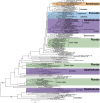Turning the crown upside down: gene tree parsimony roots the eukaryotic tree of life
- PMID: 22334342
- PMCID: PMC3376375
- DOI: 10.1093/sysbio/sys026
Turning the crown upside down: gene tree parsimony roots the eukaryotic tree of life
Abstract
The first analyses of gene sequence data indicated that the eukaryotic tree of life consisted of a long stem of microbial groups "topped" by a crown-containing plants, animals, and fungi and their microbial relatives. Although more recent multigene concatenated analyses have refined the relationships among the many branches of eukaryotes, the root of the eukaryotic tree of life has remained elusive. Inferring the root of extant eukaryotes is challenging because of the age of the group (∼1.7-2.1 billion years old), tremendous heterogeneity in rates of evolution among lineages, and lack of obvious outgroups for many genes. Here, we reconstruct a rooted phylogeny of extant eukaryotes based on minimizing the number of duplications and losses among a collection of gene trees. This approach does not require outgroup sequences or assumptions of orthology among sequences. We also explore the impact of taxon and gene sampling and assess support for alternative hypotheses for the root. Using 20 gene trees from 84 diverse eukaryotic lineages, this approach recovers robust eukaryotic clades and reveals evidence for a eukaryotic root that lies between the Opisthokonta (animals, fungi and their microbial relatives) and all remaining eukaryotes.
Figures


Similar articles
-
Phylogenomic Analyses of 2,786 Genes in 158 Lineages Support a Root of the Eukaryotic Tree of Life between Opisthokonts and All Other Lineages.Genome Biol Evol. 2022 Aug 3;14(8):evac119. doi: 10.1093/gbe/evac119. Genome Biol Evol. 2022. PMID: 35880421 Free PMC article.
-
Broadly sampled multigene trees of eukaryotes.BMC Evol Biol. 2008 Jan 18;8:14. doi: 10.1186/1471-2148-8-14. BMC Evol Biol. 2008. PMID: 18205932 Free PMC article.
-
Taxon-rich phylogenomic analyses resolve the eukaryotic tree of life and reveal the power of subsampling by sites.Syst Biol. 2015 May;64(3):406-15. doi: 10.1093/sysbio/syu126. Epub 2014 Dec 23. Syst Biol. 2015. PMID: 25540455
-
Evolution of the protists and protistan parasites from the perspective of molecular systematics.Int J Parasitol. 1998 Jan;28(1):11-20. doi: 10.1016/s0020-7519(97)00181-1. Int J Parasitol. 1998. PMID: 9504331 Review.
-
Progress towards the Tree of Eukaryotes.Curr Biol. 2019 Aug 19;29(16):R808-R817. doi: 10.1016/j.cub.2019.07.031. Curr Biol. 2019. PMID: 31430481 Review.
Cited by
-
The Isochores as a Fundamental Level of Genome Structure and Organization: A General Overview.J Mol Evol. 2017 Mar;84(2-3):93-103. doi: 10.1007/s00239-017-9785-9. Epub 2017 Feb 27. J Mol Evol. 2017. PMID: 28243687 Review.
-
Discovery of unconventional kinetochores in kinetoplastids.Cell. 2014 Mar 13;156(6):1247-1258. doi: 10.1016/j.cell.2014.01.049. Epub 2014 Feb 27. Cell. 2014. PMID: 24582333 Free PMC article.
-
A broad phylogenetic survey unveils the diversity and evolution of telomeres in eukaryotes.Genome Biol Evol. 2013;5(3):468-83. doi: 10.1093/gbe/evt019. Genome Biol Evol. 2013. PMID: 23395982 Free PMC article.
-
Bacterial proteins pinpoint a single eukaryotic root.Proc Natl Acad Sci U S A. 2015 Feb 17;112(7):E693-9. doi: 10.1073/pnas.1420657112. Epub 2015 Feb 2. Proc Natl Acad Sci U S A. 2015. PMID: 25646484 Free PMC article.
-
The eukaryotic tree of life from a global phylogenomic perspective.Cold Spring Harb Perspect Biol. 2014 May 1;6(5):a016147. doi: 10.1101/cshperspect.a016147. Cold Spring Harb Perspect Biol. 2014. PMID: 24789819 Free PMC article. Review.
References
-
- Adl SM, Simpson AGB, Farmer MA, Andersen RA, Anderson OR, Barta JR, Bowser SS, Brugerolle G, Fensome RA, Fredericq S, James TY, Karpov S, Kugrens P, Krug J, Lane CE, Lewis LA, Lodge J, Lynn DH, Mann DG, McCourt RM, Mendoza L, Moestrup Ø, Mozley-Standrdge SE, Nerad TA, Shearer CA, Smirnov AV, Spiegel FW, Taylor MFJR. The new higher level classification of eukaryotes with emphasis on the taxonomy of protists. J. Eukaryot. Microbiol. 2005;52:399–451. - PubMed
-
- Arisue N, Hasegawa M, Hashimoto T. Root of the eukaryota tree as inferred from combined maximum likelihood analyses of multiple molecular sequence data. Mol. Biol. Evol. 2005;22:409–420. - PubMed
-
- Baldauf SL, Roger AJ, Wenk-Siefert I, Doolittle WF. A kingdom-level phylogeny of eukaryotes based on combined protein data. Science. 2000;290:972–977. - PubMed
-
- Brinkmann H, Philippe H. Berlin (Germany): Springer-Verlag; 2007. The diversity of eukaryotes and the root of the eukaryotic tree. Eukaryotic membranes and cytoskeleton: origins and evolution; pp. p. 20–37. - PubMed
Publication types
MeSH terms
Substances
Grants and funding
LinkOut - more resources
Full Text Sources
Other Literature Sources

